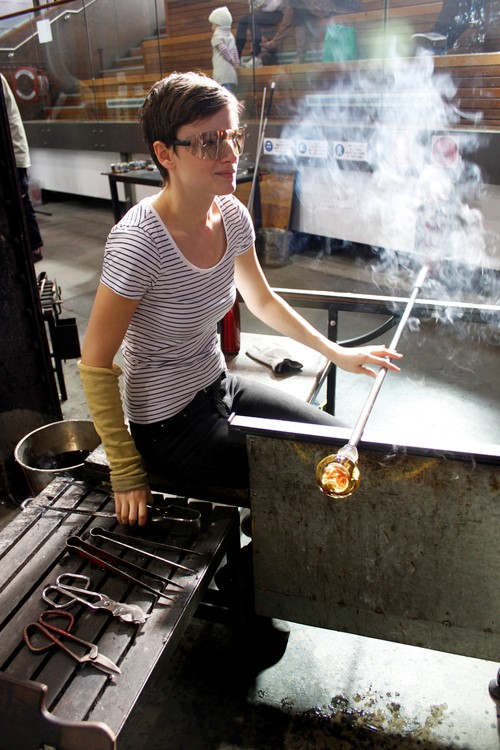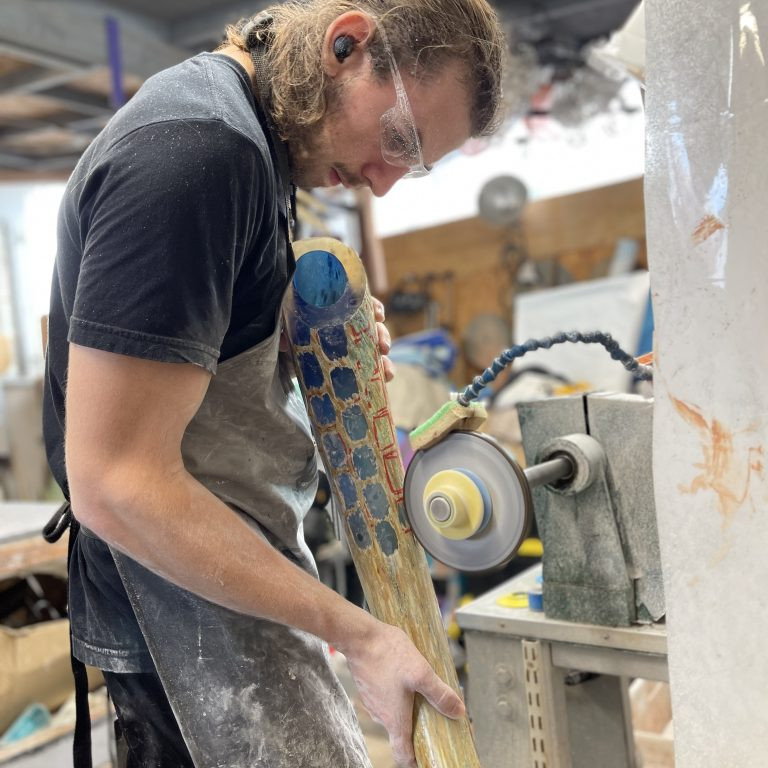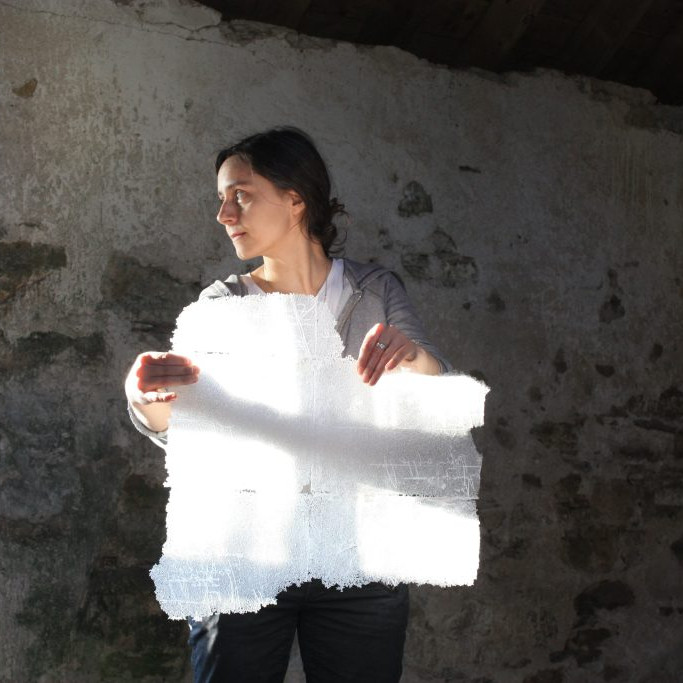Emilie Patteson Glass Artist - Canberra, Australia
Can you discuss how you use the life cycle in your current work?
Growth / Decay
Life / Death
My work always starts with collection of natural objects. I have always collected, even from a very young age. I am forever picking up leaves, feathers, seeds, pebbles, bones, shells. I collect them because they are beautiful and delicate, and they seem precious to me. I have a desire to preserve them. The process of collecting, and then of preserving offer me time to reflect. I use these natural objects as a metaphor for life, and explore the cycles of growth and decay, and life and death, as well as the ephemeral qualities of life. While life is fleeting, death provides sustenance for new life, and so the cycle continues.
My methods of preservation involved me working directly with my collected object, and it ultimately leads to the object being destroyed. The temperatures of the glass are so fierce that they burn the object, yet trap the remnants permanently. When I work with paper, I dye the paper first with a natural dye made from plants. They object is preserved for eternity, though it is also lost in the process.
You make the comment, “It provides a chance to pause and really look” can you expand on this in relationship to your work?
My artwork tends to have a particular focus on tiny detail, on the things that we often take for granted or even miss – things like budding leaves, or the pattern on an insect wing. I feel like we are so busy rushing around all the time, that we forget to slow down and appreciate the little things that surround us. I hope that my work creates that quite time of reflection, where one can reconnect with the things they are missing.
Your work Preserved Impermanence discuss?
This series speaks strongly of life cycles. It is made in components: the top section is a blown glass dome, underneath it is a piece of wattle. The wattle is sitting on a base of solid glass that contains remnants of burnt wattle trapped in golden bubbles.
 Preserved Impermanence II, 2014, 41cm x 12cm x 12cm (largest piece) Blown and hot sculpted glass with wattle inclusion and dried wattlePhotography by David Paterson
Preserved Impermanence II, 2014, 41cm x 12cm x 12cm (largest piece) Blown and hot sculpted glass with wattle inclusion and dried wattlePhotography by David Paterson
I’m inspired by scientific glass, as well as natural history collections. They are definitely big influences for this series. I’ve kept them fairly small, no more than 20cm tall, and produced a number of them, each one unique, to have the same feel of a specimen collection in a museum.
After I made this series, I made a pair preserved impermanence II, which are much larger in size. The taller of the two is 41cm. The pair sit in conversation, with the wattle pieces curved to face each other. The size of these pieces loses some of the intimacy of the smaller series, but they further draw attention to the tiny details.
Preserved impermanence, 2012-2014, Dimensions variable, Blown and hot sculpted glass with wattle inclusion and dried wattle, Photography by Stuart Hay
Compare the evolution of your own works.
The Instill series is new, and I feel that is flowed directly on from preserved impermanence. In this series I have added a third component to the composition: the top and bottom pieces are solid and contain the burnt plant remnants, and in between the two is a blown tube, that encases the dried specimen.
While preserved impermanence had the “live” specimen feeding into the “dead” specimen, the instill pieces are more like an hourglass, with the “growth” in the middle being sustained either side by the “decay”.
Discuss both the importance of collecting and storage for your work?
Collecting is what drives the work. My work changes depending on what I am collecting at a time. Sometimes I go out with a purpose of what I hope to collect, but more often than not, I tend to find things that influence me unintentionally.
When I was a little girl I had a box that I filled with my collected treasures. I kept it under my bed. I see my artwork now as my grown up collection I suppose. This is how I store my collection now.
Having said that, my studio is filled with jars of seeds, pollen, dead butterflies, and shelves are full of bones, sea urchins, seed pods. Not all my collections end up my work, but they definitely influence it one way or another!
Comment on the importance of Australian Flora in you work?
I use Australian native plants more than anything else in my work, wattle in particular. I am drawn to our flora as it is striking, delicate yet bold and unique. It’s so varied and interesting. The native plants tend to work particularly well with the glass as well. I think it has a lot of do with how oily they are. But there is also something really beautiful about burning them when so many native species rely on bushfire to burst open their seeds.
Instill Series, 2015, Dimensions variable, Photography by David Paterson. Blown, hot sculpted and assembled glass with organic inclusions and dried plants.
(L-R) Rose (Rosa species), English Lavender(Lavandula angustifolia), Persimmon (Diospyros species), Apricot (Prunus armeniaca), Chinese pistachio (Pistacia chinensis), Raspberry (Rubus species), Kangaroo Paw (Anigozanthos species)
Take one of your kiln formed brooches and expand on this aspect of your work?
My brooches are a way for me to combine both my glass and my drawing. Each brooch is made with glass, and then I engrave a little illustration of a gum leaf, feather, blossom and the like. After the engraving I rub enamel into it.
I like that they are a little piece of my artwork that you can carry around with you. Glass is a very expensive medium, and I enjoy being able to create small items that you can enjoy every day.
Selection of brooches, kiln formed, engraved and enamelled glass, photography by Stuart Hay
You also have use flora in your paper weights discuss?
My essence paperweights contain either wattle, bottle brush or lavender. They are made in the same way as I make the components for my sculptural work, which involves stuffing a piece of the plant into the molten glass, and then shaping it into the desired from.
The spherical form of the paperweight magnifies the bubbles the plant creates. You can often spot little wattle flowers, or bits of twig still whole inside. They are like little galaxies.
Essence paperweight (wattle), hot sculpted glass with wattle inclusion, hot sculpted glass with wattle inclusion
Can you discuss your work on paper?
Drawing was something that I used to only do for myself. It has only been recently that I have started to exhibit them as much as my glass.
Infused Series: Rose (Rosa species), 2015, 24.5cm x 30cm, Pencil on paper dyed with rose petals, Photography by David Paterson
I use quite thick paper, often used by print artists. The paper has to be able to withstand sometimes long periods in a dye bath. I create the dye using water and a plant, sometimes just the leaves or flowers, sometimes I throw in a hole branch! Sometimes I immerse the paper fully, other times I stand it in a bucket, and let the dye creep upwards. I’m never sure how long to leave the paper in. Sometimes they only take a few days until I’m happy with the result, other times it can be weeks. When the paper is standing in the dye, as the water evaporates it creates beautiful reticulation marks. The paper fully immersed often ends up with patterns from the leaves, and sometimes even ends up with parts of the plant embedded in the surface. Once I am happy with the dye result, I draw the plant onto the paper. It is preserved as a record, and the real plant is lost.
Infused Series: Chinese Pistachio (Pistacia chinensis), 2015, 29cm x 21.5cm, Pencil on paper dyed with Chinese pistachio leaves, Photography by David Paterson
Expand on scientific glass that you use?
Most of my work is only inspired by scientific glass. I blow my own glass to replicate some scientific forms, particularly domes, bottles and jars. Sometimes I use found glass in my work, but I prefer to create the forms myself.
Discuss your work “What You Miss”
What you miss, 2012, 30cm x 55cm, Flameworked glass with found organics, Photography by Stuart Hay
This piece is something that I hope to go back to. It’s made up of many fine tubes of glass that I have filled with deconstructed plants: pollen, stamens, crushed leaves, seeds. I also used deconstructed feathers. Sometimes form and overall mass can be distracting and take away from the tiny details. I really wanted to pull the view in to notice the tiniest of details, like the textures of wattle buds, or the colours of crushed leaves. I have arranged them in a colour gradation, so that at first you just notice the colours, but when you slide the magnifying glass across you see that there is so much more to them than colour.
What you miss (detail), 2012, 30cm x 55cm, Flameworked glass with found organics
You were awarded Highly Commended in the Youth category of the Waterhouse Natural Science Art Prize can you explain about this prize?
The Waterhouse Natural Science Art Prize is an exhibition held every year at the Museum of South Australia. The prize encourages artists to make work inspired by the natural environment, and consider environmental concerns. It is always filled with the most impressive and varied artworks! It was such an honour to have been awarded a prize! This is definitely one of my proudest moments!
Recently you exhibited in your home town Orange in rural New South Wales, Australia. How did it feel to return home in this way?
It was really special to have a solo show in my hometown. For the exhibition I collected plants from my parent’s garden. The show was titled Home Harvest. Both of my parents are big gardeners, and my mother is a trained horticulturist, so I think that was a big influence on my growing up. This exhibition was about my continuing themes of life/death and growth/decay, but it was also about how you feel connected to a place, and how easily something small and seemingly insignificant can trigger your memory and transport you there.
Emilie Patteson at work photograph by Madi Young
You trained in Canberra and have stayed on in Canberra at the Canberra Glassworks can you expand on the vibrant arts community in our Nation’s Capital, the flip side to the political life of Canberra?
I studied at the Australian National University School of Art. It’s a fantastic art school and I met so many amazing people in my time there. The ANU glass workshop is the best in Australia, and I am so privileged to have studied there.
Canberra Glassworks is the only place in Australia that is focused on contemporary glass art. When I graduated from ANU I got a studio at the glassworks and have been making work there ever since. Canberra has a thriving arts community, and there are many amazing glass artists living here. I get to work with some of the best!
There are so many great arts organisations in the ACT, as well as our national art collections. There is a lot of support for artists here, and I think that is pretty special.
Contact details.
Emilie Patteson, Canberra, Australia
Interview by Deborah Blakeley, October, 2015
Think a colleague or friend could benefit from this interview?
Knowledge is one of the biggest assets in any business. So why not forward this on to your friends and colleagues so they too can start taking advantage of the insightful information the artist has given?
Other artists you may be interested in:















